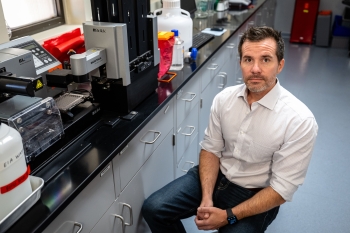Is ‘U-shaped happiness’ universal?
The Tsimane community, a forager-horticultural society in the Bolivian Amazon lowlands, was part of a first-time look at well-being among nonindustrialized communities. Photo by Benjamin Trumble
A theory that’s been around for more than a decade describes a person’s subjective well-being — or “happiness” — as having a U-shape throughout the course of one’s life. If plotted on a graph, the shape would be concave, revealing high happiness levels throughout one’s youth, declining and bottoming out at middle age — the so-called “midlife crisis” — until happiness, somewhat counterintuitively, rises again later in life.
If you live in a rich, industrialized society, this may ring true. By and large, the carefree nature of youth gives way to multiple stressors and pressures as one grows older, followed by what could be a late-life rise in contentment due to a variety of factors: more stability, acceptance and appreciation of one’s place in life, more mature relationships, etc.
However, according to new research, the U-shape of happiness is not as fundamental to humanity as previously assumed.
In a newly released paper published in the journal Science Advances, subjective well-being is said to sometimes look like a U-shape. More often, though, it is more or less flat, or even an inverted U-shape over the course of one’s life ― where happiness increases into middle age, and then declines in later life. Understanding the variability of subjective well-being across humanity is important, especially as the global population ages.
The study was led by Michael Gurven, an anthropologist with the University of California, Santa Barbara, and was co-authored by Benjamin Trumble, an associate professor of evolutionary anthropology in the School of Human Evolution and Social Change, along with other researchers.
“Most research examining happiness is conducted in sedentary urban populations, which ignores a lot of the variation that exists worldwide. However, by only studying happiness in metropolitan settings, we are missing much of the diversity that exists worldwide,” explains Trumble, who is also a research associate with ASU's Institute of Human Origins.
“There are still many people worldwide who rely on physically active subsistence strategies, like farming, hunting or fishing. In the U.S., most people don’t rely on physical activity to get food. That isn’t the case worldwide. As people age, it gets harder to do physical labor, so in populations that have to work to get food from their environment, we thought that might influence associations between age and well-being.”
‘Sporadic evidence’
To test their hypothesis that the happiness curve is more variable among rural, subsistence-oriented societies, the researchers turned to age profiles of well-being by combining three studies, making it the largest compilation to date of nonindustrialized populations around the world.
The first study covered three Indigenous populations: the Baka (Africa) and Punan (Borneo) hunter-gatherers, as well as Tsimane horticulturalists, to get a sense of how they rate their subjective well-being. The second study took a broader, cross-sectional view, looking at reports of subjective well-being from forest users in 23 low-income countries; these data allowed the researchers to adjust for many variables that might account for the age effects. The third was a longitudinal study, honing in on depression in the Tsimane population over time, which allowed the researchers to assess whether patterns observed in a cross-section show up when looking at how well-being changes in the same people over time. Two of the studies also included interviewer evaluations, which provides an independent check on the usual self-reports in well-being studies.
Taking the results together, the researchers found “only sporadic evidence for both a midlife slump and a U-shaped relationship between subjective well-being and age,” according to the study. Rather, they found more evidence for a decline in happiness after middle age, due to diminished physical function, compromised health and less involvement in social networks.
“What unites all these different populations is that they’re all rural, and their livelihoods rely more on subsistence than ties to markets or service jobs,” Gurven said. “They’re using their bodies to generate income, and so a healthy body is needed to make a living.” Their subjective well-being is often tied to being valued by others, he added. How well they can provide food, income and other services for their family, neighbors and communities is vital, so as people in these kinds of societies decline physically, their happiness may decrease.
Contrast that with the industrialized Global North societies that have institutionalized social safety nets such as health insurance, workers’ compensation and formal retirement, or have pursuits and occupations that lean less on physical capacity. These types of accommodations can help people in urban, industrialized societies overcome some of the challenges of physical aging, Gurven said.
The disparity between the researchers’ results and the U-shaped happiness curve illustrates a lack of diversity in studies of human populations. More than a decade ago, the phenomenon of studying human psychology from limited samples was called the WEIRD problem — people from WEIRD, or Western, educated, industrialized, rich democracies, still represent the vast majority of studies in the social sciences.
Studies like this are important not only because they contribute to the broader role of ecology and culture in shaping human psychology; as a practical matter, they also focus attention on unmet health demands in some of the more vulnerable areas of the world.
“By 2030, there are expected to be more than 2.3 billion adults over age 50 worldwide. Many of those older adults will be from rural areas of the Global South, which are oftentimes overlooked by researchers studying topics like aging or happiness. Most medical research is conducted in the U.S. and Europe, so understanding what contributes to well-being and happiness in these overlooked populations is going to be extremely important if we want healthy aging for everyone on the planet,” Trumble said.
More Health and medicine

ASU's Roybal Center aims to give older adults experiencing cognitive decline more independence
For older people living alone and suffering from cognitive decline, life can be an unsettling and sometimes scary experience.Arizona State University is out to improve that experience.Two projects…

Dynamic data duo advances health research
The latest health research promises futuristic treatments, from cancer vaccines to bioengineered organs for transplants to medical nanobots. While these technologies may one day be…

New study reveals high levels of toxins in seized cannabis from Arizona and California
A recent study conducted by researchers from Arizona State University has uncovered alarming levels of Fusarium mycotoxins in illicit cannabis samples seized in Arizona and California.The study found…


